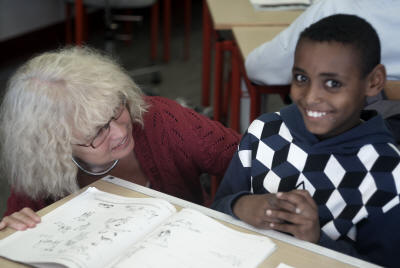What does cooperative learning mean?
You can say
that COOPERATIVE LEARNING was invented by Dr. Spencer Kagan from
California. In the sixties he and his team were studying how
kids interacted when they were playing together. Which elements
made the kids cooperate and which elements had the opposite
effect. From their studies here Dr. Spencer Kagan and his team
developed a new way of teaching, COOPERATIVE LEARNING.
Since 1990
many teachers in the USA have started practising this new method
called, COOP.LEARNING. The method works both in the kindergarten
as well as in the high school.
The idea
behind COOP.LEARNING is that each and every pupil in a class is
active during a lesson the whole time! No pupil is left/forgotten
behind sitting inactive during lessons.
But how does a teacher fullfill such aims in a class-room with
perhaps 28 pupils?
Well, the
teacher makes the pupils work in teams.
In each
team there are 4 pupils. It is essential that the teacher forms
the teams. Each team consists of a weak pupil, two pupils from
the middle group and a bright pupil.
If possible
two girls and two boys in a group, but it is certainly not a
must. The four pupils must be seated like this, the weak pupil
at the same desk as the middle one, the bright one at the same
desk as the other middle pupil, and the weak pupil must be
facing the middle pupil, and the bright one must be facing the
other middle one.
If the
number of pupils in a class is not divisible by four, you may
put five pupils in some of the teams.
How does the teacher teach in cooperative learning?
A. The
teacher sets a task.
B. Individual
time for each pupil to consider how to solve the problem.
C. Dialogue
with your neighbour, where you try to solve the problem.
Discussion in the team in order to solve the problem.
The teamís
solution to the problem is introduced to the whole class.
In this way each pupil in a
class is active during the whole lesson. No pupil must sit
inactive waiting until the teacher has got time for her/him.
Every pupil is in a dialogue, gets sparring and has feedback in
each lesson. Thatís why no one is getting bored and therefore
starting making noise or disturbing the others.
The pupils
also become more responsible towards each other and towards the
teaching going on.
This way of
teaching brings democracy into the class-room.
Normally
the teacher will form new teams after six weeks or so. It
depends on the group of pupils you are teaching.
Class-room rules
This
teaching may cause a lot of noise in a class-room. Therefore you
need some rules.
We have a
special sign for silence. The teacher puts up his hand, when he
wants attention from his pupils, and when the pupils see his
hand they also put up their hands and they stop talking or
writing. It only takes a few seconds before the class is silent.
We also
teach the pupils to use long and short voices, which means, you
talk with a short voice when speaking to your neighbour, but you
use a long voice when speaking to the whole class.
In this way
the pupils learn how to control the noise in their class-room.

